Today Cam & I kicked off a fast play ‘style’ ACW Campaign, where we start off in 1861 with an identical sized brigade each, and these will grow and change over the course of our battles, with units being reduced by attrition but gaining in experience (while also losing their élan to a degree with that experience), or being reduced to the level they are disbanded or destroyed on the battlefield, while other units will arrive to reinforce these forces, gradually increasing our commands’ from Brigades to Divisions…
It’s 1861, the United States is at war, with itself! Both North and South have called forth men to defend the sovereign claims. I have been given command of a Brigade of Volunteers in the USA Army of Northeast Virginia, currently the primary force of the Northern Army on the border of Virginia – I am Colonel Ulysses P. Rickards and I am a veteran of the ante-bellum U.S. Army, having served in the Artillery. In the vicinity of my Brigade’s encampment is a Confederate Brigade (that I am charged with observing) of the CSA Army of the Potomac, under one Colonel A.P.S. Longman, like my brigade, Colonel Longman’s is made up of fresh volunteers, and is currently covering one of the main routes into Virginia from Maryland. Colonel Longman is an extremely wealthy Virginia Land Owner, who is very well connected and pre-war was regularly featured in the fourth estate and other media – a celebrity of sorts.
The details of my brigade, for your elucidation dear reader are as follows:
- 1st Massachusetts Infantry Regiment (Strength 10)
- 2nd Michigan Infantry Regiment (Strength 10)
- 12th New York Infantry Regiment (Strength 10)
- 5th US Cavalry Regiment (Strength 8)
- Company G, 1st US Artillery (2 x 6pdr, 1 x Howitzer)
Colonel A.P.S. Longman’s Brigade is believed to consist of the following:
- 1st Virginia Volunteer Infantry Regiment (Strength 10)
- 11th Virginia Volunteer Infantry Regiment (Strength 10)
- 17th Virginia Volunteer Infantry Regiment (Strength 10)
- 30th Virginia Cavalry Regiment, with attached Texas Rangers (Strength 8)
- 3rd Company, “Washington Artillery”, New Orleans, Louisiana (2 x 6pdr, 1 x Howitzer)
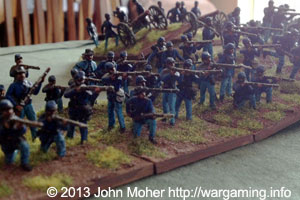
In mid-July we received orders to move off, acting as the vanguard for our army, with instructions to cross into Virginia and engage the Confederate forces. Unfortunately our ponderous efforts to advance had alerted our enemy and unknown to us they had likewise set forth north to establish a more forward defensive position – consequently Millman’s Brigade and mine became involved in a meeting engagement along the Warrenton Turnpike which evolved into general engagement for both armies. It was about 1pm in the afternoon on the 18 July when we saw the dust of Millman’s approaching columns, and I rapidly ordered the troops to deploy. Unfortunately the 5th Cavalry had ended up at the rear of my column (due to delays watering their horses in the summer heat), and consequently I ordered my 3 Infantry Regiments into line of battle supported by my artillery. Colonel Millman’s Brigade looked to only have it’s vanguard present (the Virginia Cavalry, one regiment of infantry, and the Washington Artillery), and I was confident some rapid execution by our men could see us get weight of numbers against them and give them a good dusting before their full force would be brought to bear…
The enemy’s cavalry and artillery demonstrated aggressively in front of us but we were not perturbed the 12th New York, a fine body of recruits, were dispatched to my left, through some open woodland, to come upon the enemy from their right, while the 1st Massachusetts advanced directly in the region of the turnpike, and the 2nd Michigan with my artillery moved to our right to secure some high ground and prevent any turning movement by the enemy… Shortly after the 5th Cavalry arrived and I deployed them as my central reserve. Our manoeuvres were somewhat amateurish in hindsight, the formation of our troops was not especially regimented, and we looked somewhat more like large bodies of revellers heading for 4th of July celebrations than organised military formations! As we advanced and our formations shook out into their battle formations, I observed more of the enemy arriving – already deployed in line of battle. I would realise later Longman now had all of his force present.
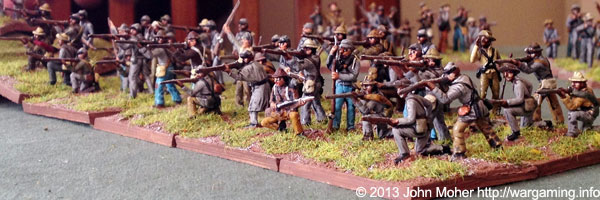
Speed was of the essence to endeavour to achieve the local superiority I envisaged, and once drawn up in line of battle the 12th NY and 1st MA continued to advance aggressively on the enemy, the former having cleared their woods and were now moving up onto a low ridge to overlook the enemy’s right – however the enemy cavalry (which we came to identify as the 30th Virginia Cavalry with an attached company of Texas Ranger Irregulars) rode rapidly across our front, demonstrating in front of us and paying little head to our unfortunately very poor musketry in their direction! Colonel Longman had by how however established his lines, and deployed his artillery (the 3rd Company of the well known “Washington Artillery” battalion from New Orleans in Louisiana) to help cover his slightly vulnerable right – however I had my mean push on, as I rode from regiment to regiment exhorting them forward to victory. My reserve, the 5th US Cavalry, I now instructed their Colonel to dismount his mean and prepare for action on foot – I expected to send them forward as improvised infantry to support and complete my soon to be successful assault, and at worst for them to cover any gaps that may appear in my lines…
There was soon the regular rattle of musketry along out lines, as our skirmishers began to earnestly exchange their lead with that of the enemy and I awaited the deep booming to indicate my artillery had now begun it’s bombardment of the enemy – being an experienced artillery officer I had put much focus into the training of the battery in my brigade, and had the eye for a good position – and I desired the comfort of hearing that arm going about it’s business with the enemy… On my right the 17th Virginia Volunteer Infantry had advanced rapidly (partly through a tall field of crops) and were now exchanging skirmish fire with the 2nd Michigan, as the booming of Company G’s guns finally rang out – and a very deadly bombardment it was striking the 1st VA Infantry with deadly accuracy! The battle was slowing intensifying, unfortunately the 30th VA Cavalry had managed to get past the 12th NY, and had now turned my left flank, aggressively moving through the woodland on my left – the 12th NY were unable to respond as they were now actively engaged to their front by the 11th Virginia Volunteer Infantry Regiment, and an ongoing series of of musket volleys and charges would ensue here for the rest of the battle…
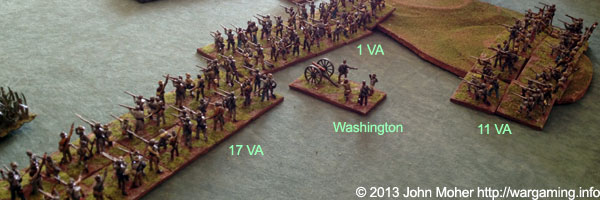
The first casualties began to accumulate amongst my troops, the 12th NY most notably, but for now we were giving more than we received (3 to 1)! Both sides now engaged in charges on both flanks, and inflicted casualties – ours being most successful on our right (the 2nd MI). However this now allowed the 30th VA Cavalry to come thundering out of the woodland into the rear of the 1st MA Infantry in my centre, a most undesirable event (and what would be the beginning of a fearsome reputation for this rebel cavalry)! To their credit the Massachusetts men did fight the horsemen off, but not without heavy casualties – it was a rough experience for my stout boys from New England, and was repeated on my right when the 17th VA gave the 2nd MI a very rough handling with the bayonet. However the 12th NY had repaid in kind to the 11th VA who similarly suffered heavy casualties from our bayonet charge although they too suffered more losses (but casualties now favoured the CSA by 7 to 8).
In the centre I determined to push forward and endeavour to decide matters with our bayonets, the 1st MA charged the enemy through the large field of green wheat, while on the right the 2nd MI and my artillery determined to bury the 17th VA in shot and shell. On my right the depleted 12th NY now shook out into a full firing line, to maximise their musketry, and I now ordered the dismounted cavalry forward to check the advance of the wild Virginia Cavalry. My opponent, Col. Longman, may have felt he was getting the upper hand, but I now ordered forward all my units in yet another bayonet charge designed to force a decision at one point or ‘tother, and I hoped regain the upper hand! However my brave men were thrown back everywhere and casualties continued to mount ( now favouring the CSA by 7 to 11). The rebel’s now charged themselves, on my left the 12th NY was hit by the 11th VA, in the centre rear the 30 VA Cav (later to be dubbed the “Lynchburg Cougars” by my men) charged my dismounted cavalrymen of the 5th, and on my right a charge by the 17th VA against the Michigan Regiment didn’t eventuate as the former found themselves partially obstructed by rough ground…
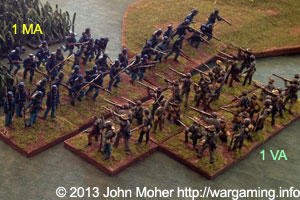
The results were decisive for Longman’s CSA force, the 12th NY disintegrated on my left and despite their outstanding courageous actions to date, they disappeared to the rear as a rabble! In the centre the 5th Cavalry fought of their Virginian adversaries, but not without heavy casualties – the casualty count now heavily favoured the CSA (8 to 19) – and the battle was effectively over, my men were spent and there was nothing for it but an ignominious withdrawal from the field – our first action had not gone well…
We spent the next few days recovering and mustering our forces, the remnants of the 12th New York Infantry were reconstituted (with a strength of just 3 from the original 10). They would no longer be especially enthusiastic about bayonet charges, their baptism having changed their demeanour from eager recruits to seasoned veterans – but the rest of my force remains determined to march to Richmond. There was also much talk of Colonel Robert Cowdin, of the 1st MA, who distinguished himself most heroically. My brigade is now constituted thus:
- 1st Massachusetts Infantry Regiment (Strength 8; Hero)
- 2nd Michigan Infantry Regiment (Strength 8)
- 12th New York Infantry Regiment (Strength 3; Veteran)
- 5th US Cavalry Regiment (Strength 7)
- Company G, 1st US Artillery (2 x 6pdr, 1 x Howitzer)
- Victory Points Earned: 3
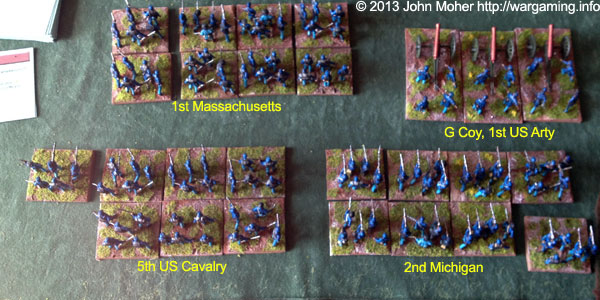
We subsequently received intelligence that Colonel A.P.S. Longman’s Brigade is in high morale, and many of their losses returned to their units very quickly post-battle, leaving his formation to now number:
- 1st Virginia Volunteer Infantry Regiment (Strength 8)
- 11th Virginia Volunteer Infantry Regiment (Strength 9; Hero)
- 17th Virginia Volunteer Infantry Regiment (Strength 9)
- 30th Virginia Cavalry Regiment, with attached Texas Rangers (Strength 7)
- 3rd Company, “Washington Artillery“, New Orleans, Louisiana (2 x 6pdr, 1 x Howitzer)
- Victory Points Earned: 6
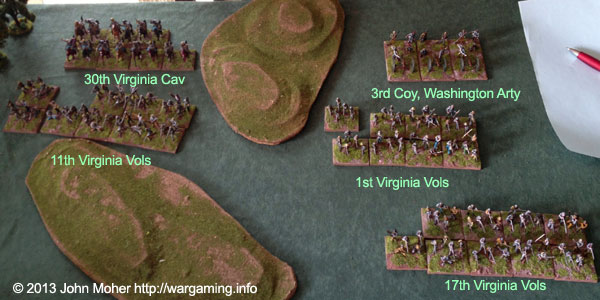
Colonel David Funsten of the 11th VA Infantry, was apparently the toast of the rebel brigade – his heroics being attributed to deciding the battle when the 12th NY were broken… News filtering through from the south also indicates that Colonel A.P.S. Longman is the toast of Richmond, he is apparently attributed with single-handedly winning the greater battle for the CSA Army of the Potomac, with being the saviour of Richmond, and that he will lead the triumphant CSA forces into Washington once the CSA are victorious!
Meanwhile my Brigade and I headed into winter camp to rebuild and train.
















Good stuff, looking forward to seeing this develop. Be interested in hearing how Longstreet plays (it looks like you are playtesting it). Cheers
Thanks Scruff – yep we are looking forward to getting a few more games in… And I can’t comment specifically on the latter – but I’m sure you will find my ongoing blog posts on this campaign of interest! 😉